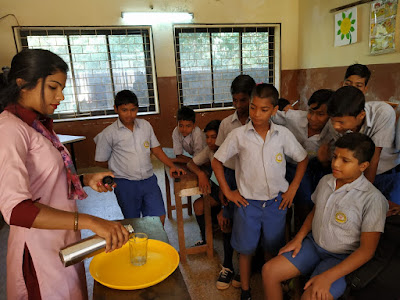D
Here are some of the discrepant events which I have showed in the class.
1.Disappearing Penny:-
Procedure:- In this experiment first we take penny and then we put it
in a glass and then we pour water into the glass.
Concept:- The trick behind the Disappearing Money experiment is the
refraction of light. When we poured water into the glass, it was as though the
penny had disappeared, but it was really just some bending light rays. After
traveling through the water and the side of the glass, none of the rays were
able to reach our eyes. Refraction occurs because of the molecules in the
substance such as water, the refraction is greater because the molecules are
closer together. So when the light rays are
traveling from the money through the water, they are refracted and cannot make
it to our eyes.
2.Water walking on string:-
Procedure:-
2. Fill one cup about halfway with water
3. Soak the string in the water for 10 seconds or until it is soaked through
4. Put one end of the string into the cup with water and hold the other end above the empty cup
5. Hold the cup with water up, using your pointer finger to keep the string at the bottom of the rim as you turn it towards the empty cup
6. Pour the water slowly along the string… watch as it clings to the string and drips off the end into the empty cup.
Concept:- Water has some special properties, making it a very unique substance. It has both strong “cohesive” and “adhesive” properties. What this means is that water can stick to itself (cohesion) and other things (adhesion). This goes down to the molecular level in how a water molecule looks: it has two hydrogen atoms and one oxygen atom. These atoms end up having positive and negative charges, which cause them to stick to one another. And it makes a stream of water as it flows down the string in this experiment!
At first, we soak the string in the water, and the water adheres to it. Even though water may drip out of it, it is still soaked in there. That is adhesion. When you pour water along it, you notice the water clings to other water molecules attached to the string, and you see it form a little stream underneath the string. That is cohesion.












No comments:
Post a Comment